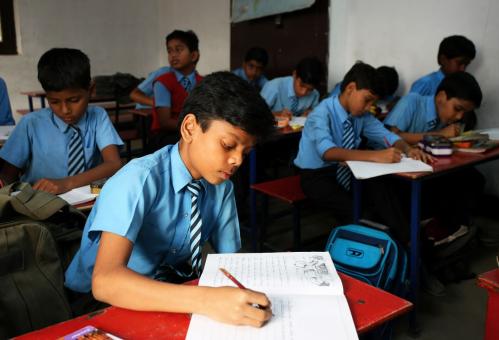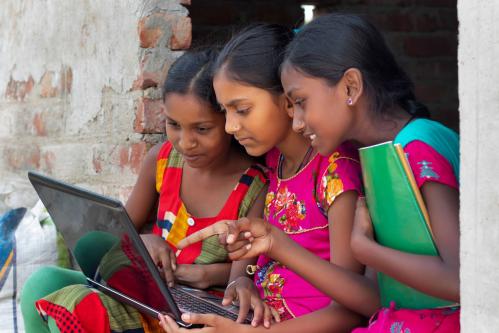Content from the Brookings Institution India Center is now archived. After seven years of an impactful partnership, as of September 11, 2020, Brookings India is now the Centre for Social and Economic Progress, an independent public policy institution based in India.
Despite universal primary school enrolment in India, many adolescent girls drop out of school after completing eight years of compulsory schooling. A gender gap in school enrolment appears and grows during teenage years (Muralidharan & Prakash, 2018). What explains the appearance of a gender gap in schooling as children enter adolescence? Some of the existing explanations focus on access to school infrastructure, the burden of housework and returns to education for girls. In a recent study, I examine a previously unexplored driver of female enrolment— the onset of menstruation, or, menarche (Khanna, 2019).
Menarche is not only a critical biological change, but also has immense sociocultural significance in the Indian context. When a girl starts menstruating, norms of her interaction with her family and her community change completely (Seymour, 1999). Menarche is marked by rituals and celebrations (Dharmalingam, 1994), and is followed by restrictions on the girl’s day-to-day activities during her menses (Mahon & Fernandes, 2010; Kumar & Srivastava, 2015). Menarche marks the girl’s transition into womanhood and the beginning of a critical period in her life when “she has acquired the capability to reproduce but she has no authority to do so” and her “vulnerability is at its peak” (Dube, 1988). To ensure their daughter’s safety, parents often restrict her mobility. In this cultural context, I demonstrate that an earlier onset of menarche has a large and significant impact on school enrolment.
Effect of Early Menarche on Enrolment
The main challenge of isolating the effect of early menarche on school enrolment is that adolescence is a period of critical transitions, such as the transition from primary to secondary school. Any association between early menarche and schooling may in fact be driven by other transitions that girls experience during this period. To overcome this challenge, I compare the trends in the enrolment rate between ages eight and twelve for girls who reached menarche before age twelve (girls in the early menarche group) with those who reached menarche after age twelve (girls in the late menarche group). The underlying idea is that the enrolment rate for girls in the late menarche group at age twelve represents the hypothetical enrolment rate for girls in the early menarche group at the same age if they had not reached menarche.
In this study, I use data on 1,000 representative children in Andhra Pradesh (now Andhra Pradesh and Telangana). Figure 1 charts the trends in enrolment for three groups of children: girls who reached menarche before age twelve, girls who reached menarche after twelve, and boys. While the enrolment rate does not differ across the three groups of children at age eight, there is a precipitous drop in the enrolment rate of girls in the early menarche group between ages eight and twelve. Trends in enrolment for boys and for girls in the late menarche group are almost identical. I find that starting menses before age twelve leads to a 12% point decline in school enrolment rate, and this decline is 13% relative to the enrolment rate of girls in the late menarche group at age twelve (91%).
Figure 1: Enrolment Rate, by Gender and Menarche Status

The magnitude of the estimated effect of early menarche on school enrolment is sizeable. Indeed, it is similar to the effect of various education related policies and reforms in India. For instance, a school-latrine construction initiative increased middle school enrolment by 8% (Adukia, 2017). Providing free school lunch to primary school students increased the primary school enrolment rate by 7.3% (Kaur, 2016), whereas giving free bicycles to school-going teenaged girls increased their school enrolment by 32% (Muralidharan & Prakash, 2017).
Human Development and Menarche
Healthy students are better learners. Not only do healthier children perform better and stay longer in school, they also get better job opportunities and higher incomes (Almond & Currie, 2015). Among girls, however, childhood nutrition is also known to be linked to their menarcheal timing: better nourished girls tend to reach menarche before others in their cohort. Indeed, girls in the early menarche group are about two centimeters taller and over five kilograms heavier than their peers. As I show in this study, they are also more likely to drop out of school after menarche, and potentially lose some of their initial health advantage. Restrictive social norms around menstruation, therefore, undermine gains from improved nutrition for girls and become another driver of gender gaps in human development.
What it Means for Policy
By showing that early menarche increases female dropout rate, this study argues that safety concerns and social norms are an important barrier to adolescent girls’ schooling. Indeed, interventions that address these concerns, such as separate-sex toilets (Adukia, 2017) and providing bicycles to teenage girls (Muralidharan & Prakash, 2017), have been successful in encouraging female enrolment. Therefore, any policy designed to promote girls’ schooling should address adolescent girls’ safety concerns. The larger problem lies in the gender-restrictive norms that pervades all periods of a girl’s life, including adolescence. In addition to innovative policy interventions, addressing gendered deprivations will require challenging these beliefs and attitudes.
References
Adukia, A. (2017). Sanitation and education. American Economic Journal: Applied Economics, 9(2), 23-59.
Almond, D., & Currie, J. (2011). Human capital development before age five. In Handbook of Labor Economics (Vol. 4, pp. 1315-1486). Elsevier.
Dharmalingam, A. (1994). The Implications of Menarche and Wedding Ceremonies for the Status of Women in a South Indian Village. Indian Anthropologist, 24(1), 31-43.
Dube, L. (1988). On the Construction of Gender: Hindu Girls in Patrilineal India. Economic and Political Weekly, Vol. 23, No. 18, WS11-WS19.
Kumar, A., & Srivastava, K. (2011). Cultural and social practices regarding menstruation among adolescent girls. Social Work in Public Health, 26(6), 594-604.
Khanna, M. (2019). The Precocious Period: The Impact of Early Menarche on Schooling in India. Gui2de Working Paper Series No. 05. Georgetown University.
Mahon, T., & Fernandes, M. (2010). Menstrual hygiene in South Asia: a neglected issue for WASH (water, sanitation and hygiene) programmes. Gender and Development, 18(1), 99-113.
Muralidharan, K., & Prakash, N. (2017). Cycling to school: increasing secondary school enrollment for girls in India. American Economic Journal: Applied Economics, 9(3), 321-50.




Commentary
The precocious period: Impact of early menarche on schooling in India
October 15, 2019